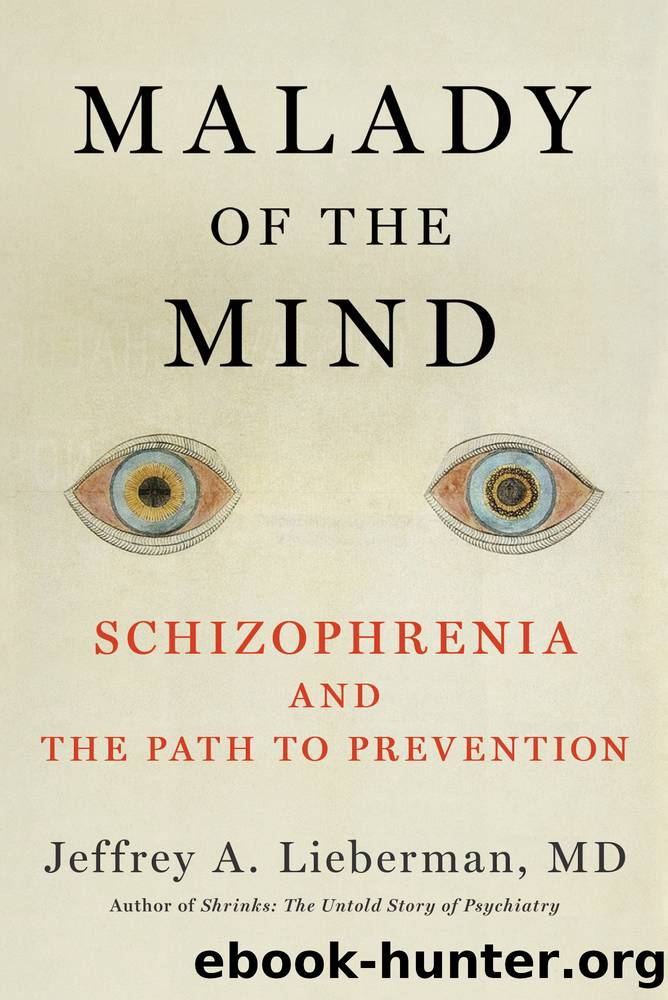Malady of the Mind by Jeffrey A. Lieberman

Author:Jeffrey A. Lieberman
Language: eng
Format: epub
Publisher: Scribner
Published: 2023-02-21T00:00:00+00:00
ALTERNATIVE DIAGNOSES
Advances in medical science are often slow to impact psychiatry; this includes precision medicine. However, when the renowned geneticist David Goldstein was recruited to Columbia to become director of the Institute for Genomic Medicine, I saw an opportunity to tap into his expertise. Given the enormity of the challenge in pinpointing the cause(s) of schizophrenia, Goldsteinâs recommendation was to focus on what he called âextreme phenotypes.â These were unusual cases of schizophrenia in which the patients had distinct features in terms of illness severity, dysmorphia (deformity or abnormality in the shape or size of certain parts of the body), lack of treatment response, and poor outcomes reflected in persistent symptoms and cognitive decline. Goldstein speculated that while most schizophrenia patients had polygenic forms of the illnessâmeaning the involvement of tens or hundreds of common genes, each with low penetrance but contributing additively to a personâs disease riskâthe most severely ill patients (extreme phenotypes) had higher rates of rare mutations of individual genes with high penetrance, meaning genes that by themselves conferred a strong likelihood of developing the disease.
Goldstein had proven the utility of examining extreme phenotypes in neurological disorders such as epilepsy. If his hunch that the strategy could be applied to patients with schizophrenia was correct, it would show that the illness could take yet another genetic form. The product (the biochemical material resulting from the gene expression) of a given genetic mutation could yield critical clues about which treatment would target the aberrant protein most effectively and have the best chance of relieving patientsâ symptoms after standard antipsychotics had failed. This approach of using drugs that target mutated gene products has been studied extensively and proven successful in experiments with rodents. For extreme phenotypes, the most effective treatments may not be among those ordinarily considered for treating mental illness.
We decided to apply Goldsteinâs strategy by studying New York State mental hospital inpatients. As the policy of deinstitutionalization had pared down the state hospitalsâ population from a high of more than 558,000 in 1955 to just 52,000 in 2018, it was reasonable to suspect that among the remaining patients were the sickest of the sick, with a high proportion exhibiting extreme phenotypes. At the same time, we could also screen long-term patients for autoimmunity to see if any of them had been misdiagnosed, as Susannah Cahalan had been initially.
Along with three other faculty, I met with David to plan the study. Anthony Zoghbi was a trainee in our department with an interest in psychiatric genetics, Sander Markx was a psychiatrist who had worked with Josep Dalmau in characterizing the clinical syndrome of limbic encephalitis from which Susannah had suffered, and Terry Goldberg was a neuropsychologist whose research had focused on the cognitive deficits associated with schizophrenia.
We began by assessing the symptoms and cognitive functions of all inpatients diagnosed with schizophrenia who met criteria for extreme forms of the illness, and then taking blood samples from them to extract DNA for genotyping and antibody analyses. We considered a patient
Download
This site does not store any files on its server. We only index and link to content provided by other sites. Please contact the content providers to delete copyright contents if any and email us, we'll remove relevant links or contents immediately.
Should I Stay or Should I Go? by Ramani Durvasula(6802)
Why We Sleep: Unlocking the Power of Sleep and Dreams by Matthew Walker(5664)
Fear by Osho(4097)
Flow by Mihaly Csikszentmihalyi(4062)
Rising Strong by Brene Brown(3792)
Why We Sleep by Matthew Walker(3782)
Too Much and Not the Mood by Durga Chew-Bose(3701)
How to Change Your Mind by Michael Pollan(3690)
The Hacking of the American Mind by Robert H. Lustig(3590)
Lost Connections by Johann Hari(3462)
He's Just Not That Into You by Greg Behrendt & Liz Tuccillo(3312)
Evolve Your Brain by Joe Dispenza(3060)
What If This Were Enough? by Heather Havrilesky(2949)
Resisting Happiness by Matthew Kelly(2895)
Crazy Is My Superpower by A.J. Mendez Brooks(2869)
The Courage to Be Disliked by Ichiro Kishimi & Fumitake Koga(2813)
The Book of Human Emotions by Tiffany Watt Smith(2781)
Descartes' Error by Antonio Damasio(2745)
In Cold Blood by Truman Capote(2693)
